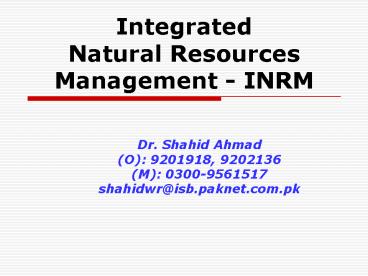Integrated Natural Resources Management INRM - PowerPoint PPT Presentation
1 / 45
Title:
Integrated Natural Resources Management INRM
Description:
shahidwr_at_isb.paknet.com.pk. What is the Resource Picture? Land Cover of Pakistan ... With Trend line using 6th Degree Polynomial Function ... – PowerPoint PPT presentation
Number of Views:2076
Avg rating:3.0/5.0
Title: Integrated Natural Resources Management INRM
1
Integrated Natural Resources Management - INRM
- Dr. Shahid Ahmad
- (O) 9201918, 9202136
- (M) 0300-9561517
- shahidwr_at_isb.paknet.com.pk
2
What is the Resource Picture?
3
Land Cover of Pakistan
4
Vegetation Zones of Pakistan
5
Vegetation Types NWFP and Punjab Provinces
6
Agro-ecological Regions of Pakistan
7
Agro-climatic Zones of Pakistan
8
Land Statistics 2002-03
(Area Million Acres)
Source Agriculture Statistics, 2002-03.
9
Productivity of Agricultural Land
Class Area ()
I. Very Good 16.1 II. Good 21.5 III. Mod
erate 14.3 IV. Poor 5.8 Total
Agricultural Productive Area 57.7 V. Good
Grazing 1.2 VI. Poor Grazing 15.6 Total
Grazing Land 16.8 VII. Agriculturally
Non-Productive 20.4 VIII. Miscellaneous
5.1
Source Agriculture Statistics, 2002-03.
10
With Trend line using 6th Degree Polynomial
Function
11
(No Transcript)
12
With Trend line using 4th Degree Polynomial
Function
13
With Trend line using Linear Function
14
With Trend line using 4th Degree Polynomial
Function
15
With Trend line using 4th Degree Polynomial
Function
16
- What does INRM mean?
17
The basics of integration
- More coordinated decision-making across sectors
and scales
18
Misconceptions
- INRM demands wholesale integration.
- Sectoral decision-making should be abandoned
entirely.
19
Risks of fully sectoral approach
- Overlooking negative impacts on environment and
other sectors - Inefficient use of resourcesnatural and
financial
Integrated approach
Sectoral approach
20
Risks of fully integrated approach
- Getting mired in complexity.
- Not making good use of specialist expertise.
Sectoral approach
Integrated approach
21
Finding a Balance
Each country needs to decide where integration
makes sense based on its social, political and
hydrological situation
Sectoral approach
Integrated approach
22
INRM Integration
Land Water Energy
Forestry Range Agriculture
INRM
People and Institutions
23
- What is the role of a strategy?
24
Catalyst for Change
- An INRM strategy and policy can be a catalyst for
action and ultimately, positive change.
25
A coherent approach to change
- A strategy should effect actionproviding a
coherent and measured approach to governance
change.
Strategy
Enabling environment
Management instruments
26
Not just another NRM Plan
- Differences between an INRM strategy and a
traditional NRM plan - Dynamic rather than staticlays down a framework
for a continuing and adaptive process of
strategic and coordinated action - Involvement from multiple sectorsfor example,
health, energy, finance, tourism, industry,
agriculture, and environment.
27
Not just another NRM Plan
- Differences between an IWRM strategy and a
traditional water plan - Broader focus that looks at water in relation to
other ingredients needed to achieve larger
development goals or meet water challenges. - More extensive stakeholder participation
28
Taking the first steps
- A strategy is an important first step, not an end
in itself.
Equity Sustainability Efficiency
Strategy
29
- INRM Progress Global and Pakistan?
30
Progress of INRM
- Some countries have made good progress towards
meeting the target. - But many more need including Pakistan to
accelerate their efforts.
Good progress
Some progress
Just beginning Including Pakistan .
31
Why slow progress?
?
- Uncertainty over
- What INRM means and how it contributes to
sustainable social and economic development - What an INRM strategy is and its role in NRM
reform - How to go about developing a policy and strategy
32
Balochistan Case
33
Water Resource Availability and Use (billion m3)
34
Tubewells(numbers)
35
Subsidy on Electric Tariff
- Subsidy for the current Year around Rs. 7.0
billion - Number of electric tubewells 14363 (2001-02)
- Estimated farms using electric tubewells 7000
- Total farms in Balochistan 2,43,000
- Percent farmers benefited from subsidy 3
36
Subsidy and Poverty Reduction
- Monthly electricity bill of electric tubewell
Rs. 40,000 - Monthly cost of diesel for diesel tubewells Rs.
28,000 - Why diesel tubewell farmer is surviving without
subsidy? - How he is performing in terms of water use and
productivity? - How he is maintaining profitability?
- Are we addressing these questions?
37
Recovery of Abiana in Pat Feeder Canal
38
Recovery of Abiana in Khirther Canal
39
IWRM Policy for Balochistan Principles and
Strategies
40
IWRM
- IWRM concepts and principles well accepted by
stakeholders - Real challenge translating concepts in to
practice - Key factor in implementing IWRM Balochistan
facing difficulty in implementing Institutional
Reforms Agenda
41
IWRMP Framework
- Basin level planning
- Water-poverty-environment as evaluation
criteria - Watershed-water-farming system approach for basin
planning
42
Land Use Systems
- Indus Basin Irrigation System
- Minor Perennial Irrigation Systems
- Sailaba Farming Spate Irrigation
- Khushkhaba Farming
- Coastal Areas
43
Guiding Principles - IWRMP
- Holistic, determined and sustainable
- Participatory and decentralized at basin level
- Delegated service delivery to customers for an
appropriate fee - Water use in society sustainable at all costs -
with a transparent policy framework - Equitable allocation of shared water resources
- Participatory and consultative leading to
commitment by stakeholders - Reforms require a commitment to sustained
capacity building, monitoring, and learning at
all levels
44
Strategies - IWRMP
- IWRMP and Action Agenda based on water sector
assessment - Establishment of Balochistan Water Resources
Management Authority as an apex organization - Invest to manage priority river basins
- Increase autonomy and accountability of service
providers - Develop incentives, regulations and awareness
- Manage shared water resources
- Enhance water information, consultation and
partnerships - Invest in capacity building, monitoring and
learning
45
Thanks
Thanks































